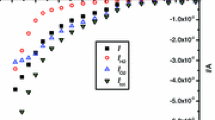Abstract
The effect of oxygen partial pressure on anode reaction of steam electrolysis using SrZr0.5Ce0.4Y0.1O3-α (SZCY-541) proton conducting electrolyte was investigated by AC impedance measurement in this work. The anode reaction was enhanced by increasing oxygen partial pressure, and this result was opposite to the expectation from the conventional anode reaction (water splitting reaction). The increase in the electrode reaction conductivity with oxygen chemical potential was proportional to \( {P_{{\mathrm{O}}_2}}^{1/4} \) at 600 °C and at higher oxygen partial pressure region of 700 and 800 °C, suggesting the possibility that the enhancement is caused by the increase in hole concentration on the electrolyte surface near the anode.








Similar content being viewed by others
References
Accorsi R, Bergmann E (1980) Cermet cathodes for high temperature water electrolysis with zirconia cells. J Electrochem Soc 127:804–811
Badwal SPS, Bevan DJM, Bockris JOM (1980) Electrode kinetics of the evolution and dissolution of oxygen at the urania-zirconia interface. Electrochem Acta 25:1115–1125
Doenitz W, Schmidberger R, Steinheil E, Streicher R (1980) Hydrogen production by high temperature electrolysis of water vapour. Int J Hydrog Energy 5:55–63
Iwahara H, Esaka T, Uchida H, Maeda N (1981) Proton conduction in sintered oxides and its application to steam electrolysis for hydrogen production. Solid State Ionics 3(4):359–363
Iwahara H, Esaka T, Uchida H, Maeda N (1982) High temperature fuel and steam electrolysis cells using proton conductive solid electrolytes. J Power Sources 7:293–301
Iwahara H, Uchida H, Maeda N (1983) Studies on solid electrolyte gas cells with high-temperature-type proton conductor and oxide ion conductor. Solid State Ionics 11:109–115
Iwahara H, Yajima T, Hibino T, Ozaki K, Suzuki H (1993) Proton conduction in calcium, strontium and barium-zirconate. Solid State Ionics 61:65–69
Iwahara H (1995) Technological challenges in the application of proton conducting ceramics. Solid State Ionics 77:289–298
Uchida H, Maeda N, Iwahara H (1983) Relation between proton and hole conduction in SrCeO3-based solid electrolytes under water-containing atmospheres at high temperatures. Solid State Ionics 11:117–124
Sakai T, Matsushita M, Matsumoto H, Okada S, Hashimoto SI, Ishihara T (2009) Intermediate temperature steam electrolysis using strontium zirconate-based protonic conductors. Int J Hydrog Energy 34:56–63
Sakai T, Matsushita M, Hyodo J, Okuyama Y, Matsuka M, Ishihara T, Matsumoto H (2012) Effect of doped ceria interlayer on cathode performance of the electrochemical cell using proton conducting oxide. Electrochim Acta 75:179–184
He F, Song D, Peng R, Meng G, Yang S (2010) Electrode performance and analysis of reversible solid oxide fuel cells with proton conducting electrolyte of BaCe0.5Zr0.3Y0.2O3-δ. J Power Sources 195:3359–3364
Sakai T, Matsumoto H, Yamamoto R, Kudo T, Okada S, Watanabe M, Hashimoto SI, Takamura H, Ishihara T (2009) Performance of palladium electrode for electrochemical hydrogen pump using strontium-zirconate-based proton conductors. Ionics 15:665–670
Sakai T, Matsumoto H, Kudo T, Yamamoto R, Niwa E, Okada S, Hashimoto SI, Sasaki K, Ishihara T (2008) High performance of electroless-plated platinum electrode for electrochemical hydrogen pumps using strontium-zirconate-based proton conductors. Electrochim Acta 53:8172–8177
Akoshima S, Oishi M, Yashiro K, Sato K, Mizusaki J (2010) Reaction kinetics on platinum electrode/yttrium-doped barium cerate interface under H2-H2O atmosphere. Solid State Ionics 181:240–248
Mizusaki J, Amano K, Yamauchi S, Fueki K (1987) Electrode reaction at Pt, O2(g)/stabilized zirconia interface. Part II: electrochemical measurements and analysis. Solid State Ionics 22:323–330
Kreuer KD (1999) Aspects of the formation and mobility of protonic charge carriers and the stability of perovskite-type oxides. Solid State Ionics 125:285–302
Author information
Authors and Affiliations
Corresponding author
Rights and permissions
About this article
Cite this article
Sakai, T., Arakawa, K., Ogushi, M. et al. Atmosphere dependence of anode reaction of intermediate temperature steam electrolysis using perovskite type proton conductor. J Solid State Electrochem 19, 1793–1798 (2015). https://doi.org/10.1007/s10008-015-2808-9
Received:
Revised:
Accepted:
Published:
Issue Date:
DOI: https://doi.org/10.1007/s10008-015-2808-9




